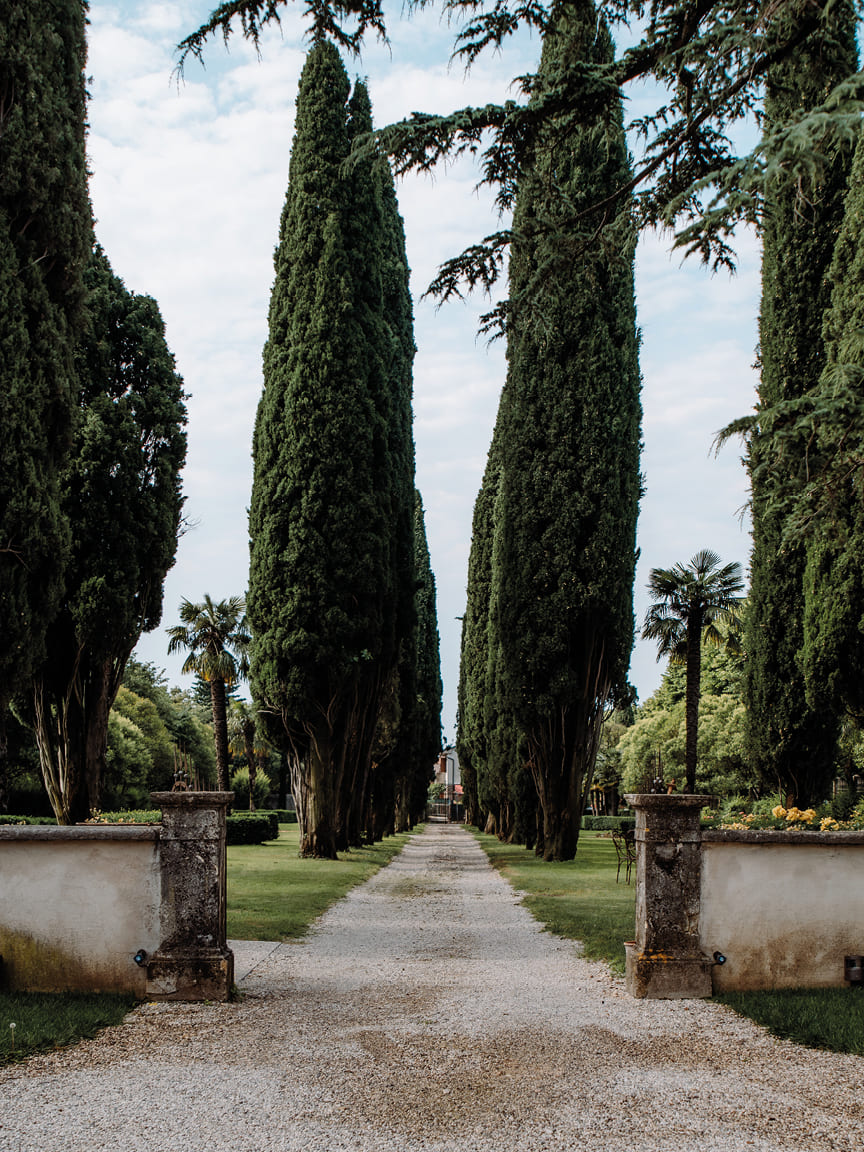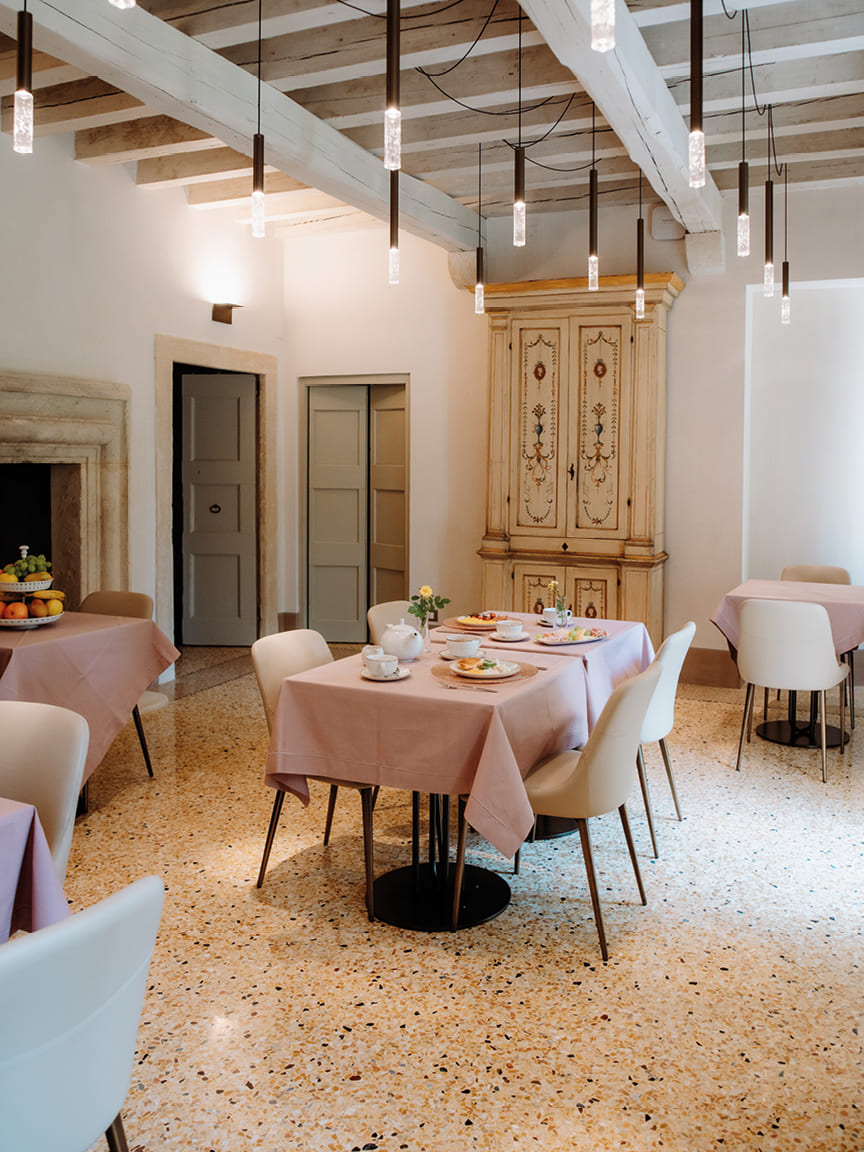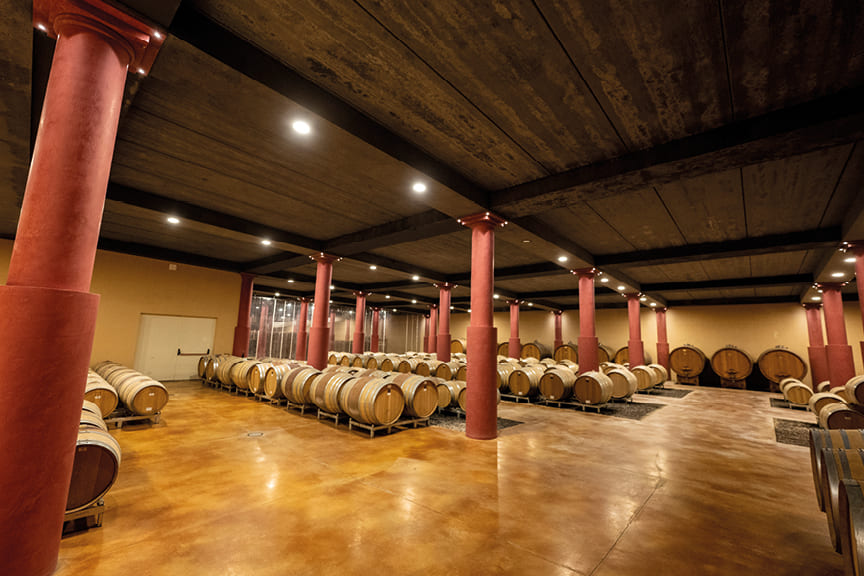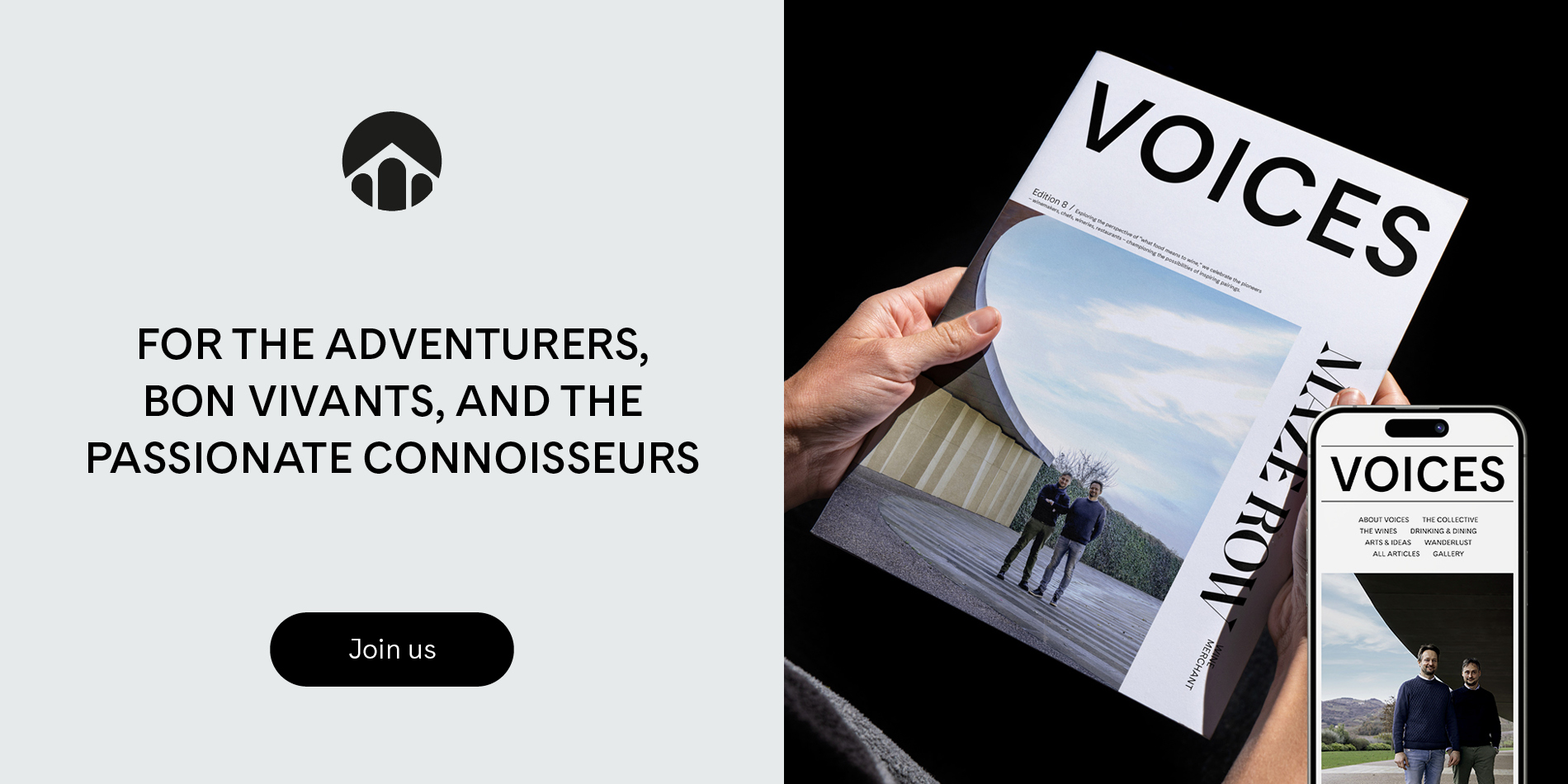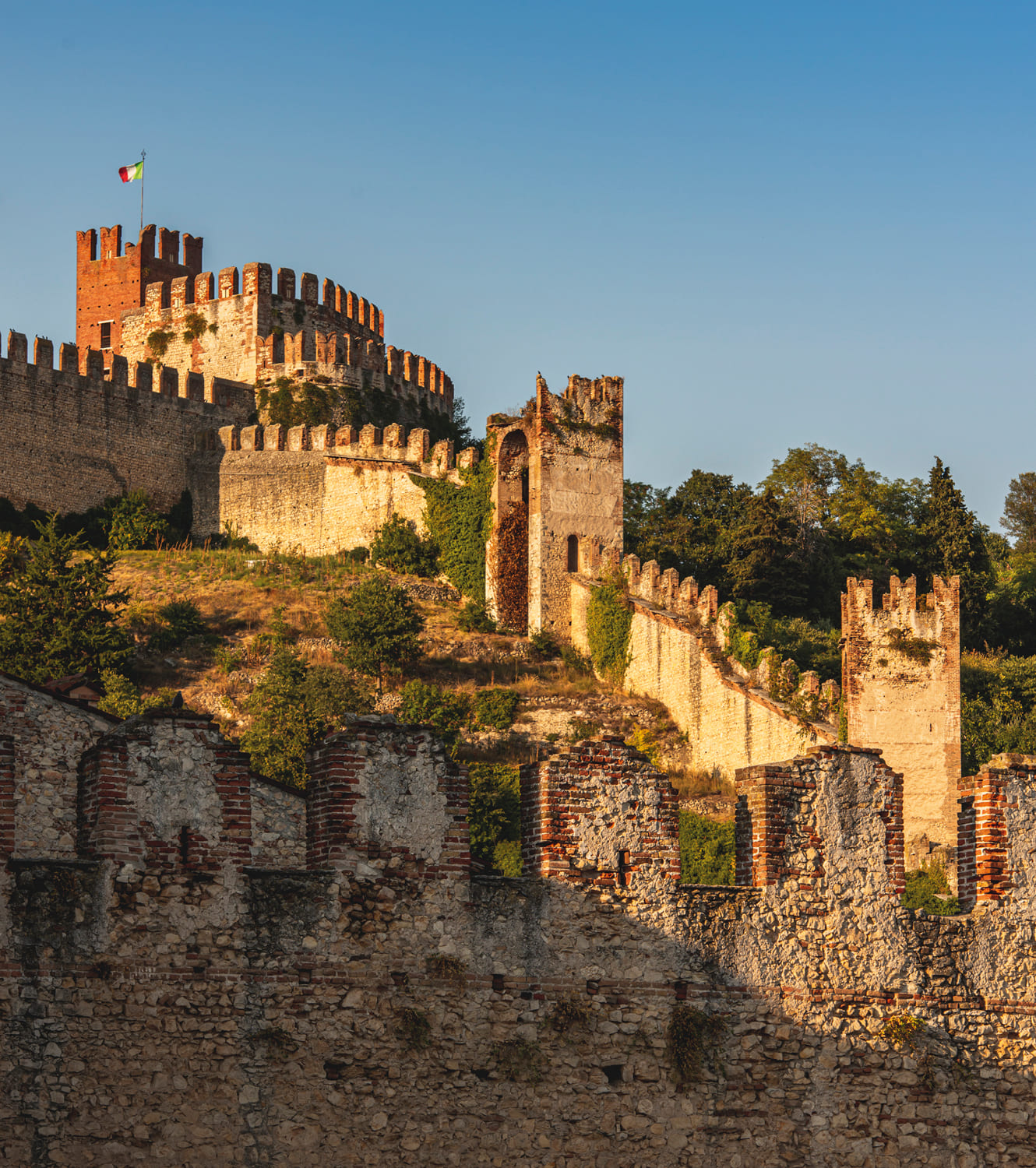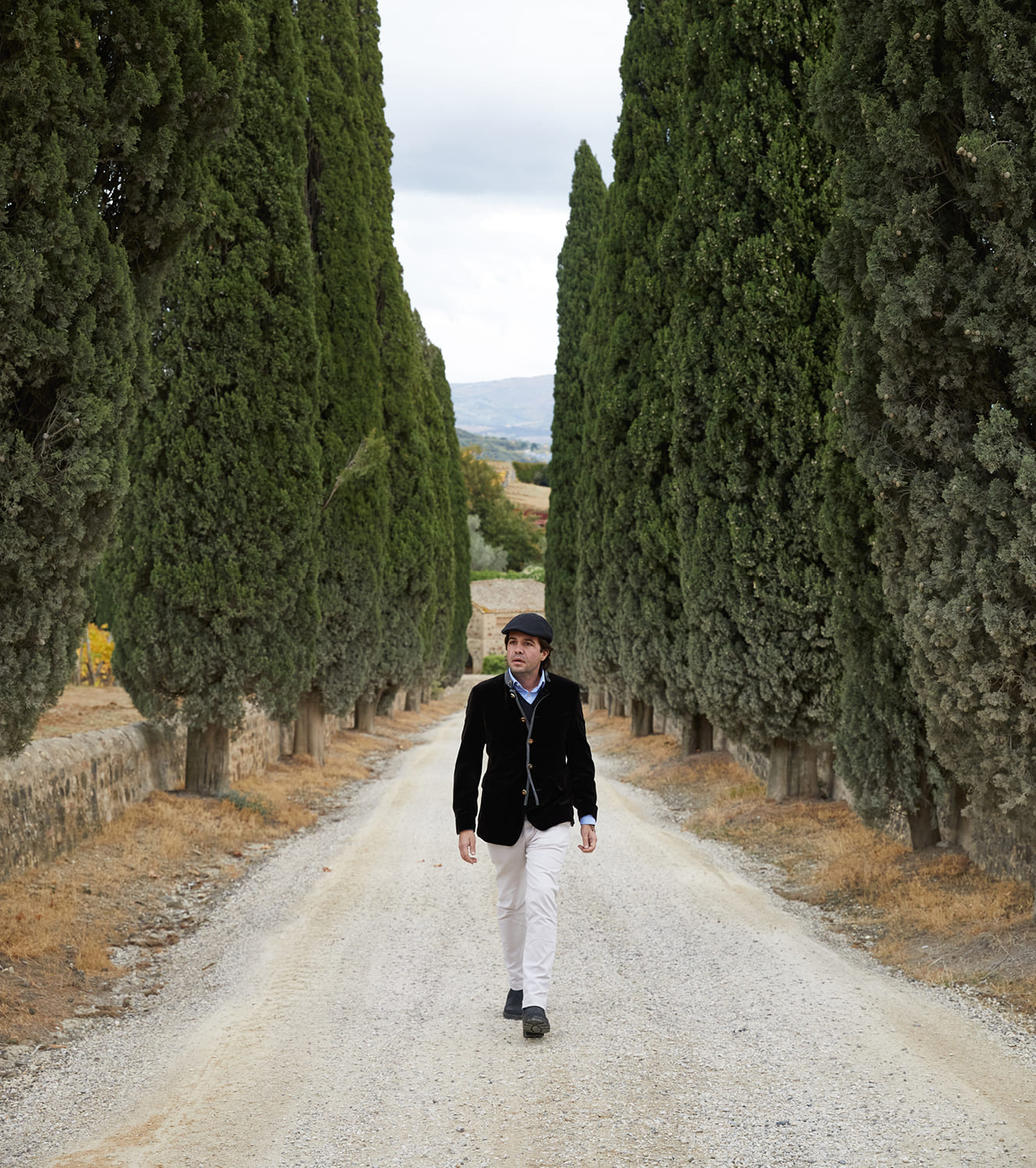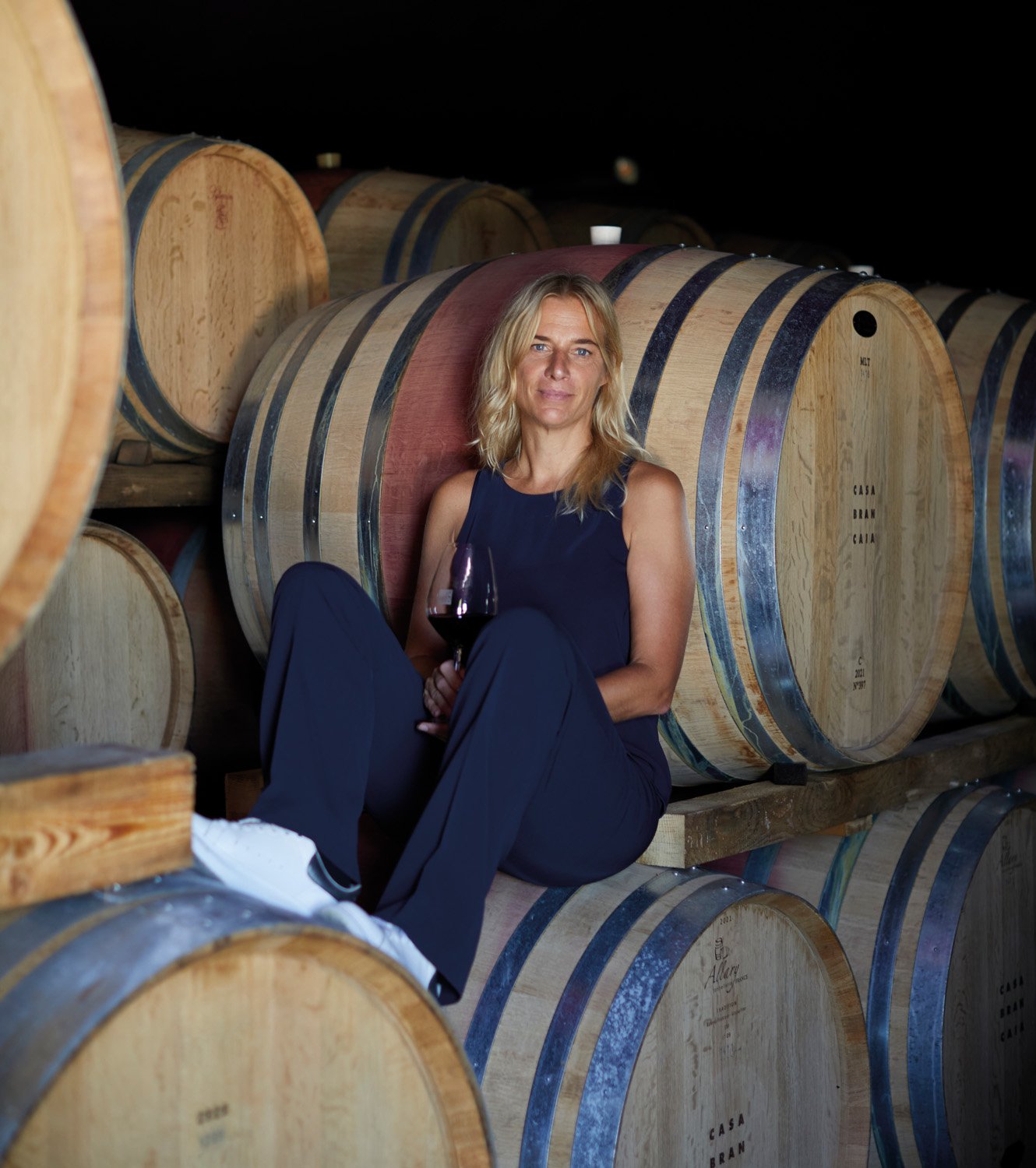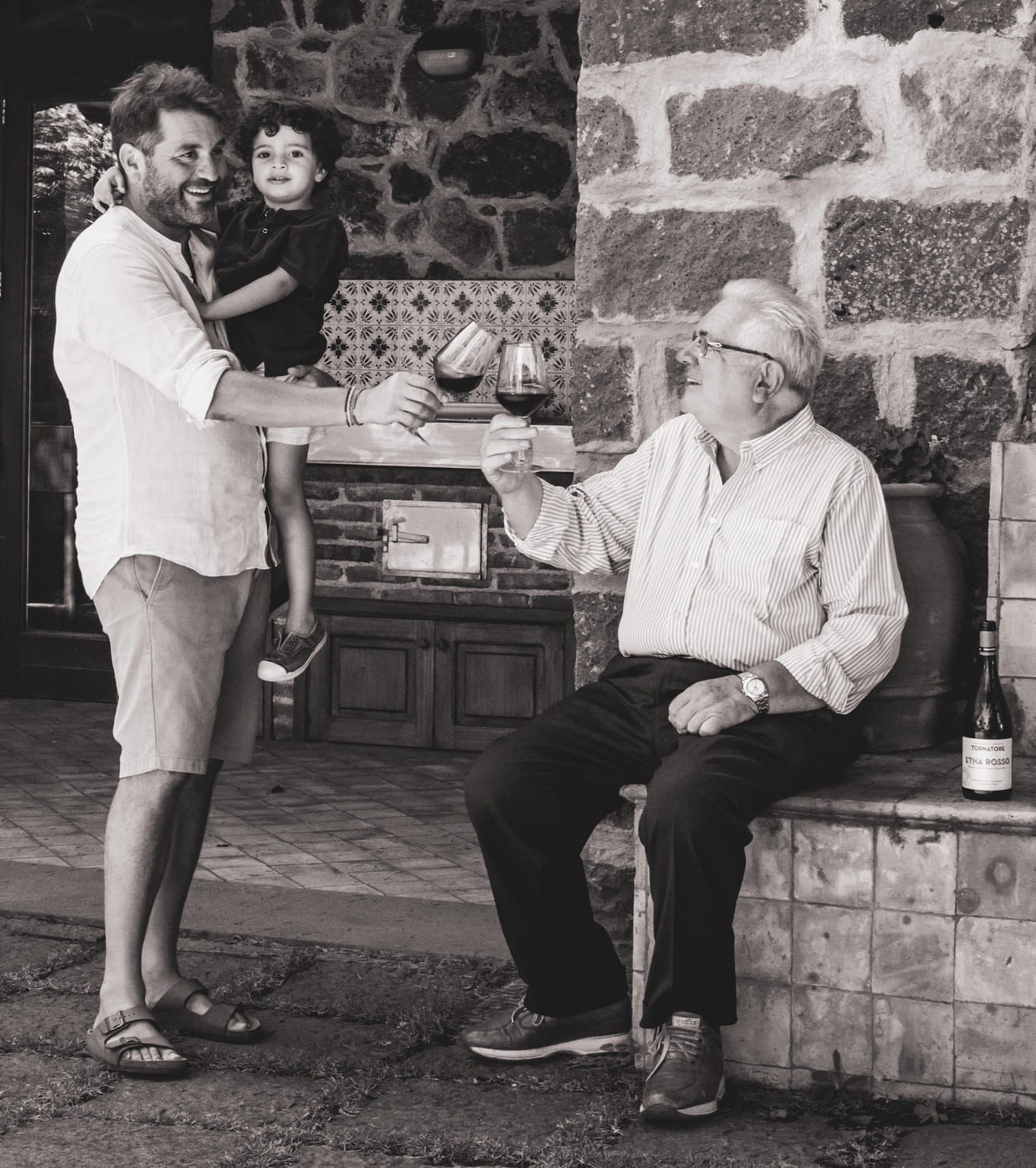
THE SOAVE BROTHERS
In an ultra-modern winery near the medieval town of Soave, Nargess Banks meets Dario and Andrea Pieropan, the brothers perfecting the family tradition of producing innovative and precious organic white wines
There’s an inscription mounted on the wall of the reception room at Cantina Leonildo Pieropan that reads: Il futuro ha un cuore antico, which roughly translates to “The future has an ancient heart.” As we step into the foyer – a vast space bathed in natural light streaming through generous windows, offering glorious vistas of the surrounding vineyards and the medieval walls of Soave – Andrea Pieropan reads the inscription aloud. “Only an ancient heart can truly understand the future. This idea is so important to us,” he says earnestly. “Without a history, your actions won’t be genuine. Pieropan represents where tradition meets innovation. We learn from tradition but always look to the future.”
Brothers Dario and Andrea inherited the winery from their father, Leonildo Pieropan, following his passing in 2018 at the age of 71. Opened officially in April 2022 and named in his honor, the winery and visitor center was a labor of love – a project that took several years to complete. Sadly, Leonildo, or Nino as he was known, never saw the building’s completion.
“Our father started the project as the business was growing, and the original building in the heart of Soave could no longer accommodate us,” Andrea explains. The land was purchased from a grower whose vineyard had been destroyed by a storm. Elderly and ready to retire, he decided to sell. “It was an ideal spot – close to many of our vineyards and right next to the house I moved to when I got married,” he says, smiling as he points to the hill behind the winery. It’s hard to imagine a more idyllic life.
The building was designed with sustainability in mind. This was an unusual step for the region when the project began to take shape in 2015, but for Pieropan, sustainability has always been a core principle. After all, they were the first winery in Soave to commit to organic farming back in 2008. Now, Pieropan is working toward achieving sustainable certification, which Andrea hopes will be granted this year.
Designed by Veronese architect Moreno Zurlo of A.c.M.e. studio (the project earned the firm several awards and significant recognition, as Andrea proudly notes), the 10,000 sq m winery is a striking blend of form and function – visually and conceptually. Nestled into the slopes of a large hill, the building is largely hidden beneath the landscape, with only the front section visible to the public. We almost missed it on the drive over – it’s that subtle.
The design reflects Pieropan’s commitment to ecological thinking. Soil removed during excavation was reused in the surrounding vineyards. The facade features local materials (brass, Vicenza stone, and Euganean trachyte) selected to weather over time, echoing the aging process of the wines inside. An innovative rainwater collection system nourishes the vineyard and supports the winery, while the underground environment conserves energy through its natural climatic stability.
It took several drafts to arrive at this contemporary design, but one thing was clear: it could not be a mere replica of Pieropan’s former winery, the 14th-century château in the center of Soave. “Our father was a person with enormous sensibility, and he would never accept moving to a place that is simply a bad copy of his original home,” says Andrea, “it had to have a different soul. With its green roof and natural material, it had to melt into its surroundings, and look like it’s always been here. And, like wine, the building will evolve with time. Like wine, this building isn’t static,” he says. “This will be the winery for not just my generation, but the next generations.”
The interior is organized around the production cycle, with careful attention to both function and hygiene. Rooms that require air and light – such as drying, vinification, bottling, laboratory, packaging, and offices – offer views over the valley, while the aging and warehousing areas are windowless and underground. Production spaces and offices are on a single level, creating a close relationship between the layout and the process. The design is understated yet stylish, finished with natural materials and a focus on color and light harmony.
“We never do things just because they look better or follow trends,” Andrea says as we pass through the bottling area with pretty spectacular views across the vineyards that produce the wines. The production facilities are closed today, but I can already sense the camaraderie such thoughtful architecture fosters among the workers. This attention to detail extends to the cellar’s warm lighting. Designed specifically for the winery, low-energy lights emit a golden hue in the La Rocca room and a reddish tone in the cellar housing the Valpolicella reds. “What better than a wine made in such a beautiful place,” says Andrea, his signature, infectious laugh following.
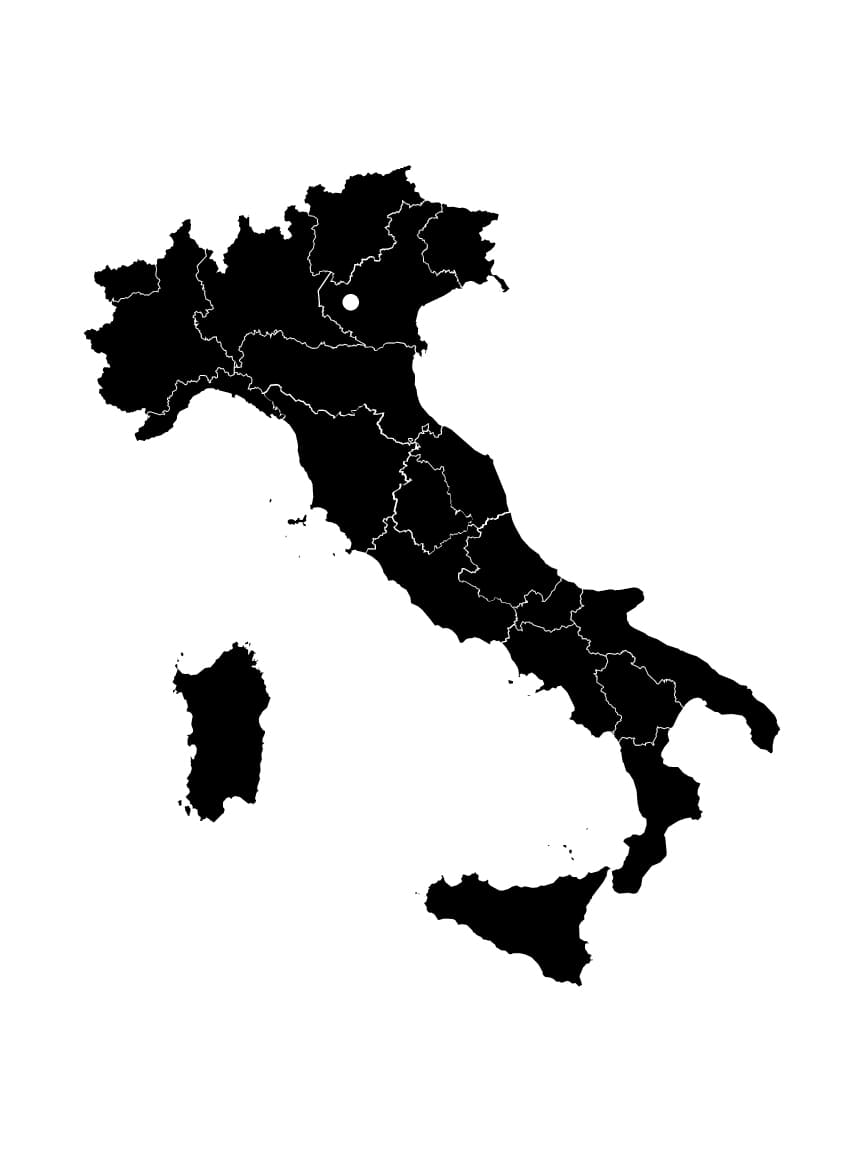
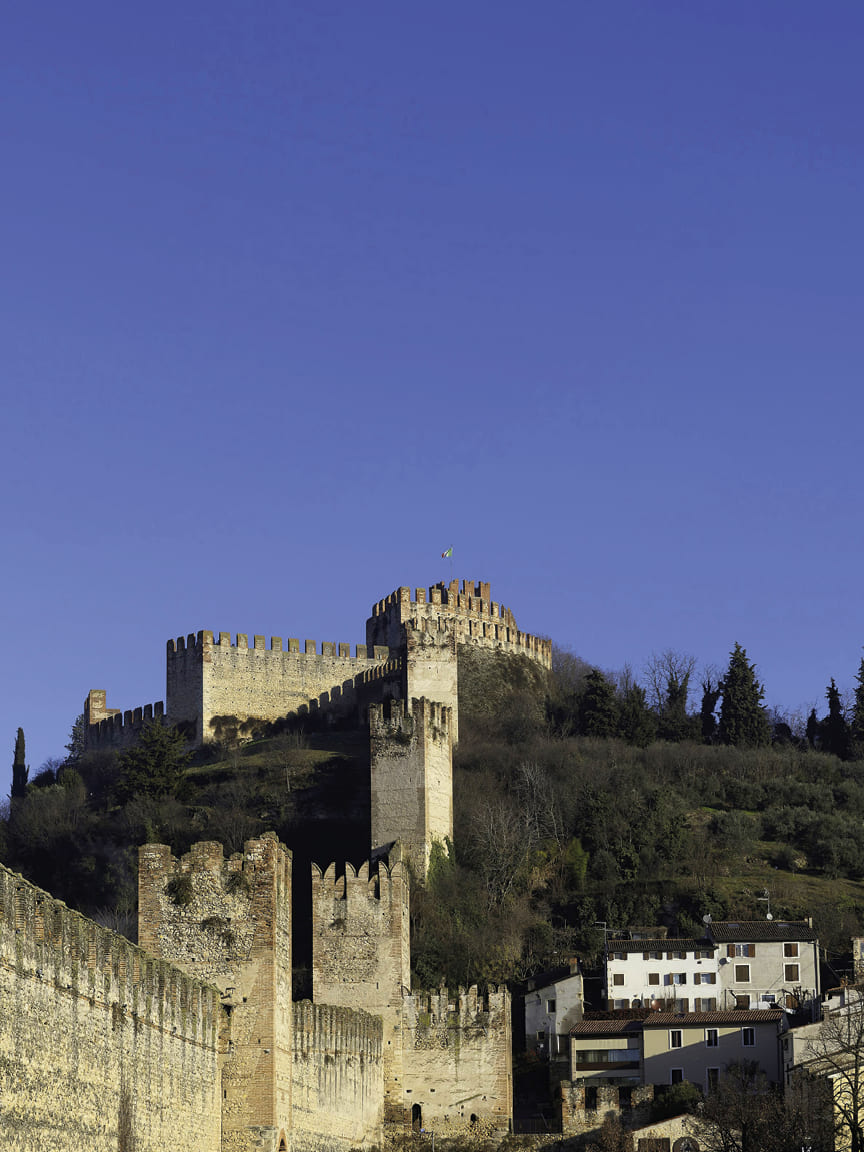
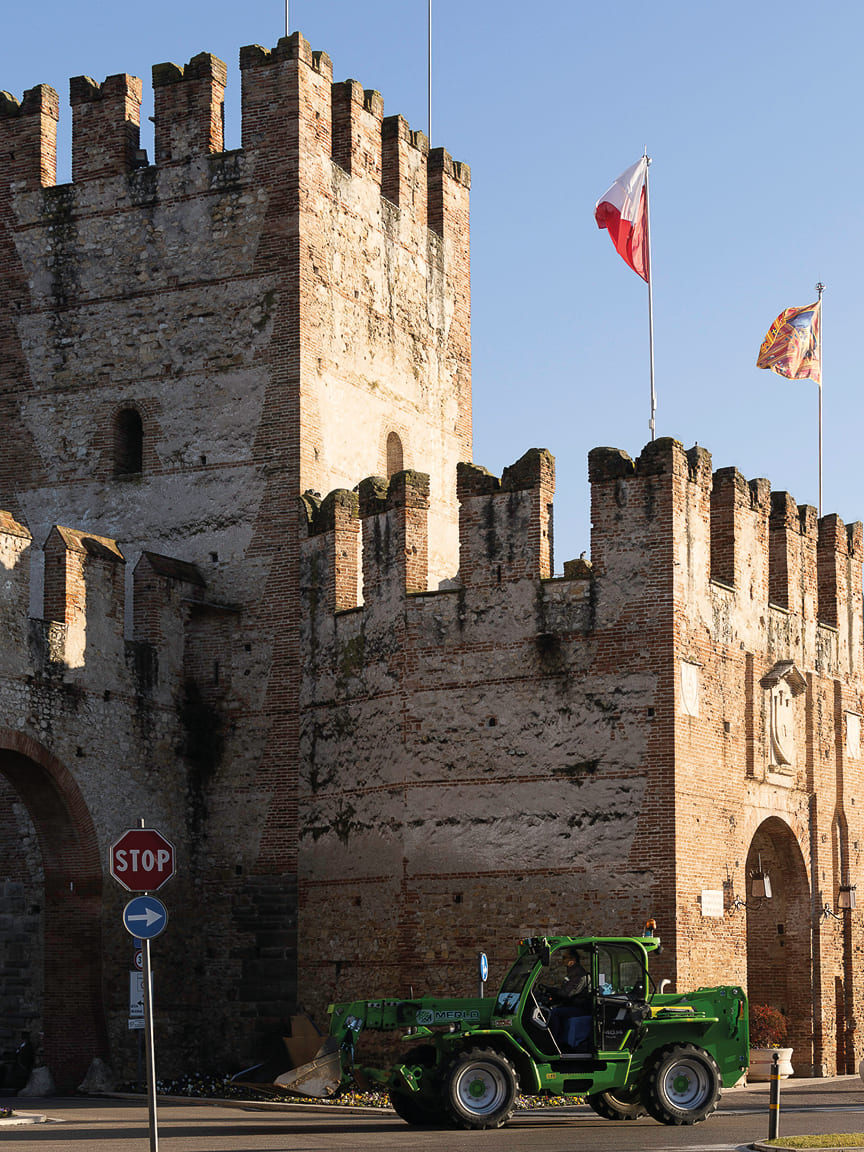
The main Pieropan winery is located just outside the medieval town of Soave, the northern Italian medieval town with its well-preserved castle
STRONG FOUNDATIONS
Founded in 1880 by Dr Leonildo Pieropan, the town’s surgeon, the winery’s origins are quite unique. “Our great grandfather left medicine because he couldn’t stand the sight of blood,” Andrea explains. Leonildo had always been passionate about viticulture, purchasing small plots and experimenting with Soave’s soils and its indigenous grapes. Leonildo’s sons, Gustavo and Fausto, carried on the family business, which was later passed to Gustavo’s only son, Leonildo (Nino). It was Nino who truly revolutionized Pieropan.
A trained viticulturist, Nino took control in 1970 during a pivotal time for the Italian wine industry. As northern producers embraced Teutonic influences and stainless steel, Nino quickly adopted these technologies. At the same time, he refocused the vineyards, selling off less productive plots to concentrate on maximizing ripeness in the best ones.
Nino was instrumental in unlocking Soave’s true potential, achieving a series of industry firsts that would define his legacy. His 1971 Calvarino was the first wine in the region to be crafted using only Italian native-grapes (Garganega and Trebbiano di Soave) from a single vineyard, and aged before release. His 1978 La Rocca was the first oaked expression for Garganega, and under his stewardship, Pieropan led the way to bottling with screw caps. Critically, Nino converted the winery to organic farming.
Andrea smiles proudly as we discuss his father. “Before Calvarino, no one had connected the vineyard to the label – the geographic location to the bottle,” he tells me, shaking his head to emphasise the critical importance of this wine. Soave wines were being exported in volume to international markets. The quality wasn’t great, nor was the reputation. For Nino to put all his knowledge in one wine was brave. Nino could see Calvarino’s potential, and the bet paid off – in time. During this period Pieropan rose to be one of the most prominent winemakers in the region.
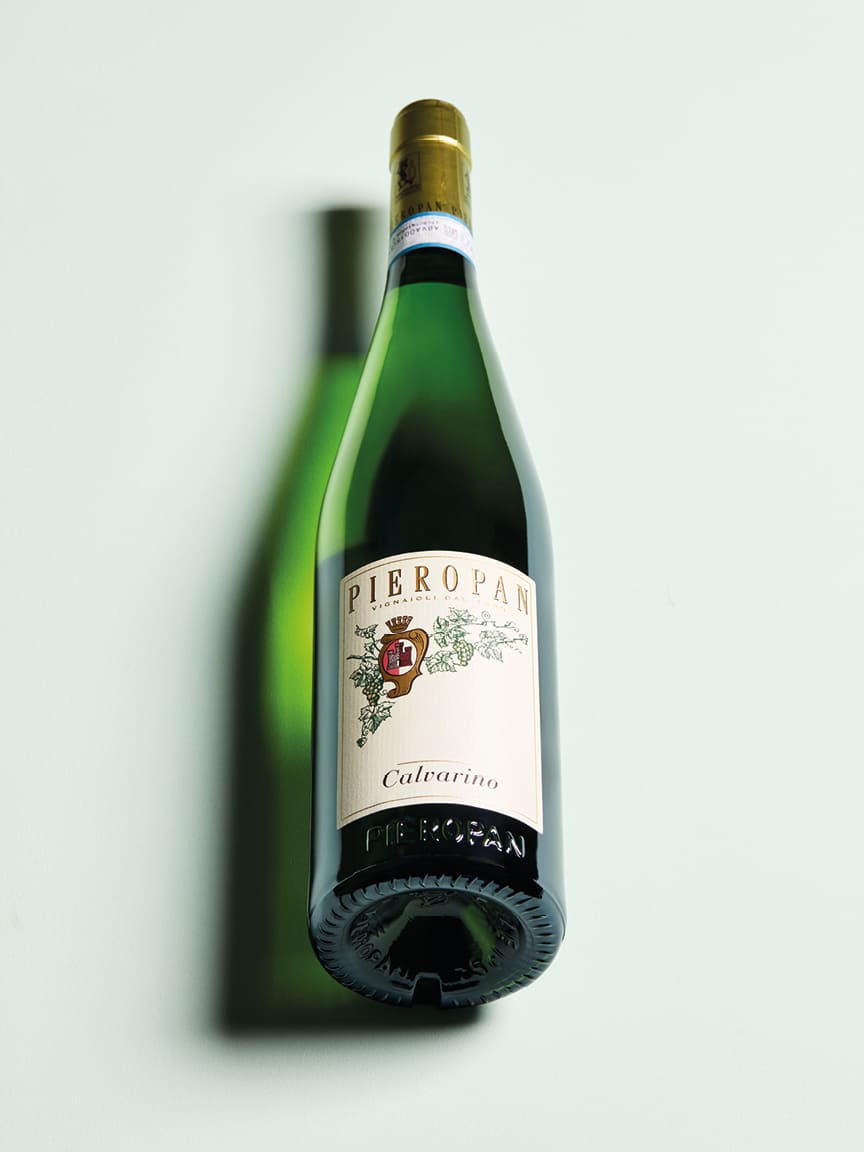
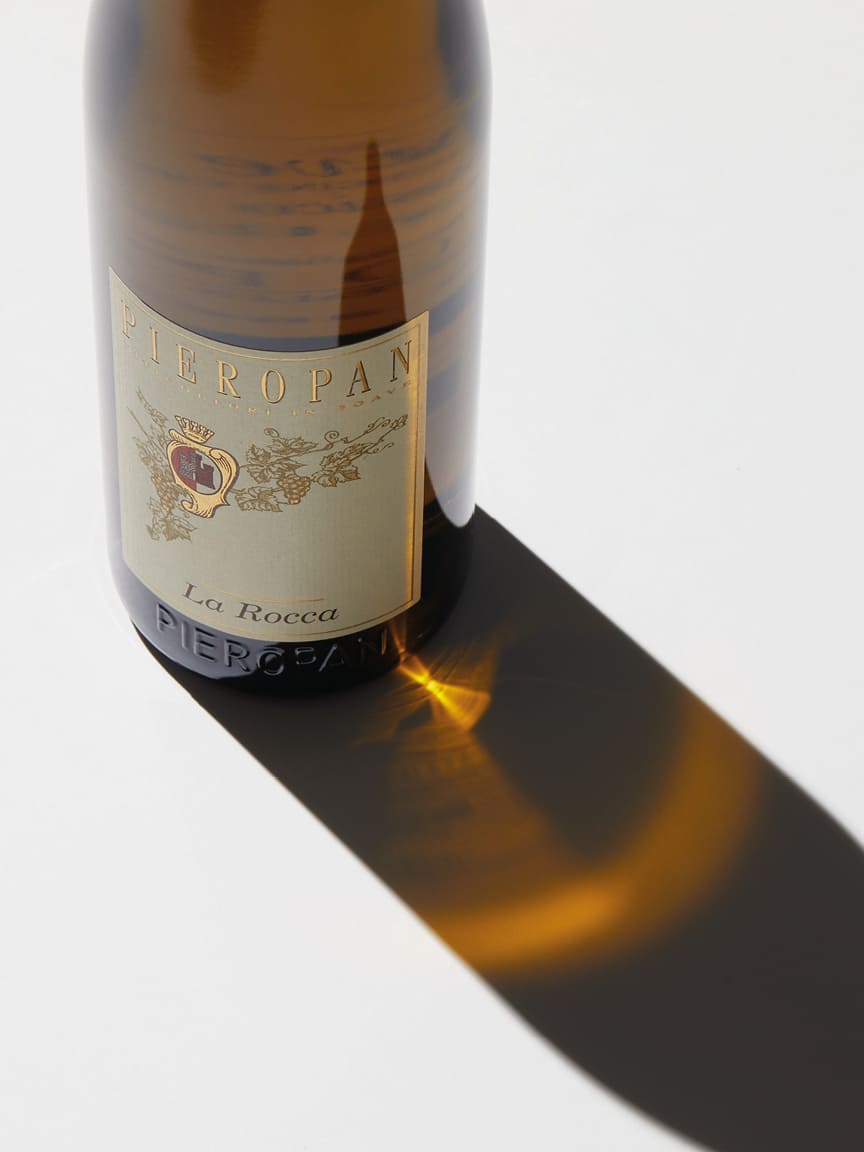
Pieropan creates three distinct Soave wines: Soave Classico and (pictured), Calvarino the pinnacle expression La Rocca
BOTTLING THE TERROIR
The Calvarino cru was the first vineyard parcel to belong to the Pieropan family. Its terraced rows benefit from a south-southwest orientation within a natural amphitheater, creating an ideal microclimate for the vines. The wine is crafted primarily from Garganega, a noble grape with deep historical roots, and Trebbiano di Soave, a variety that has gained prominence more recently. Both thrive in the vineyard’s volcanic soils, which imbue Calvarino with minerality and finesse.
It took several years for the media and market to acclimatize to Soave white wines of this caliber. Exporter Liberty Wines recognized the potential of Calvarino and successfully introduced it to the UK market, effectively communicating its quality and significance. Soon, word spread, and Calvarino began finding its way to the US and beyond. But it wasn’t an easy journey. Soave wasn’t Burgundy – the concept of high-quality, single-vineyard, terroir-driven wines simply didn’t exist for this region. Italian white wine, in general, was perceived as simple, fresh, and intended for mass consumption. Nino had to build the region’s reputation from the ground up.
“It was like landing on the moon,” Andrea says, chuckling. “My father’s vision was to bring the essence of the terroir into the bottle. His meticulous nature drove him, constantly competing with himself. Calvarino made its debut in 1971. Why then? Because my father had been observing the grapes since 1966 and knew when the land was ready for the perfect bottling. If you truly listen to the terroir, it speaks to you. If you don’t, you miss that subtle, but essential connection,” Andrea reflects.
Meanwhile, La Rocca represents the pinnacle of Pieropan’s artistry. It’s sourced from the La Rocca cru vineyard which sits on the southern slopes of Monte Rocchetta (hence the name), close to the winery and near the medieval castle of Soave. Made exclusively from Garganega, the grapes come from older vines that lend the wine incredible depth and complexity. The terroir here, distinct from the volcanic soils of Calvarino, features limestone-rich earth that imparts a richer, more nuanced minerality. Unlike the concrete-aged Calvarino, La Rocca undergoes fermentation and aging in oak barrels for a fuller-bodied Soave with a creamy texture and a layered, opulent profile.
We circle back to the beginning. How did Nino decide to barrel-age that first 1978 La Rocca for a year before releasing it, I ask Andrea. He explains that his father recognized the distinct character of the La Rocca vineyard’s grapes, noting the variance in soil and how it shaped the fruit’s profile. And he knew it called for a different approach to vinification than the Calvarino cru.
“Nobody in this region was using oak,” Andrea points out. “It was really revolutionary.” La Rocca was embraced internationally, but in Italy, the market wasn’t quite ready. Andrea reminds me that many hadn’t yet tasted Burgundian or Californian oaked Chardonnays, and their expectations for white wines leaned toward a fresher, simpler style. There was no frame of reference, he says. The shift began in the 1990s, when Italian wine critics took notice, showering both Calvarino and La Rocca with praise and high scores.
We talk about the change in today’s wine drinkers, who increasingly seek complexity in all wines, not just reds. “People are looking for more depth, more character. They want wines that are interesting. And they’re less focused on international varieties now. They’ve already experienced those,” Andrea notes. “It’s interesting to be part of this moment.”
Dario joins us in the cellar. As Pieropan’s head winemaker, the elder brother continues his father’s legacy, following a traditional yet meticulous approach to his craft. With a soft-spoken demeanor, he walks me through his process, emphasizing that in the cellar, the focus is on perfecting the technique to express the terroir, rather than adjusting practices to accommodate the variations of each vintage. Calvarino is vinified and aged in large, unpainted glass-lined concrete ‘tulipe’ tanks to preserve its fresh, mineral character, and La Rocca in sizable oak barrels ranging from 500 to 2,000 liters.
In the cellar, Dario devotes the same meticulous care to Soave Classico as he does to Calvarino. Yet, he acknowledges that while both wines share the same grape varieties, their distinct expressions stem largely from the unique characteristics of their vineyard soils. “La Rocca, though, is a very different child,” he says, “it has a stronger personality, and you have to manage it carefully in the barrel to keep it from becoming too ripe or too rich.”
Dario admits that Calvarino was once his favorite wine in the collection, but in recent years, he’s gravitated more toward La Rocca. “I think that’s partly because the style has shifted a bit since my father’s time. And since I love Calvarino, I’ve probably brought some of its character into La Rocca. My palate has changed, and that’s influenced the wine,” he says with a shy smile, adding, “It’s natural that you see the winemaker’s touch in a wine.”
“Since I love Calvarino, I’ve probably brought some of its character into La Rocca. My palate has changed, and that’s influenced the wine. It’s natural that you see the winemaker’s touch in a wine”
Dario Pieropan
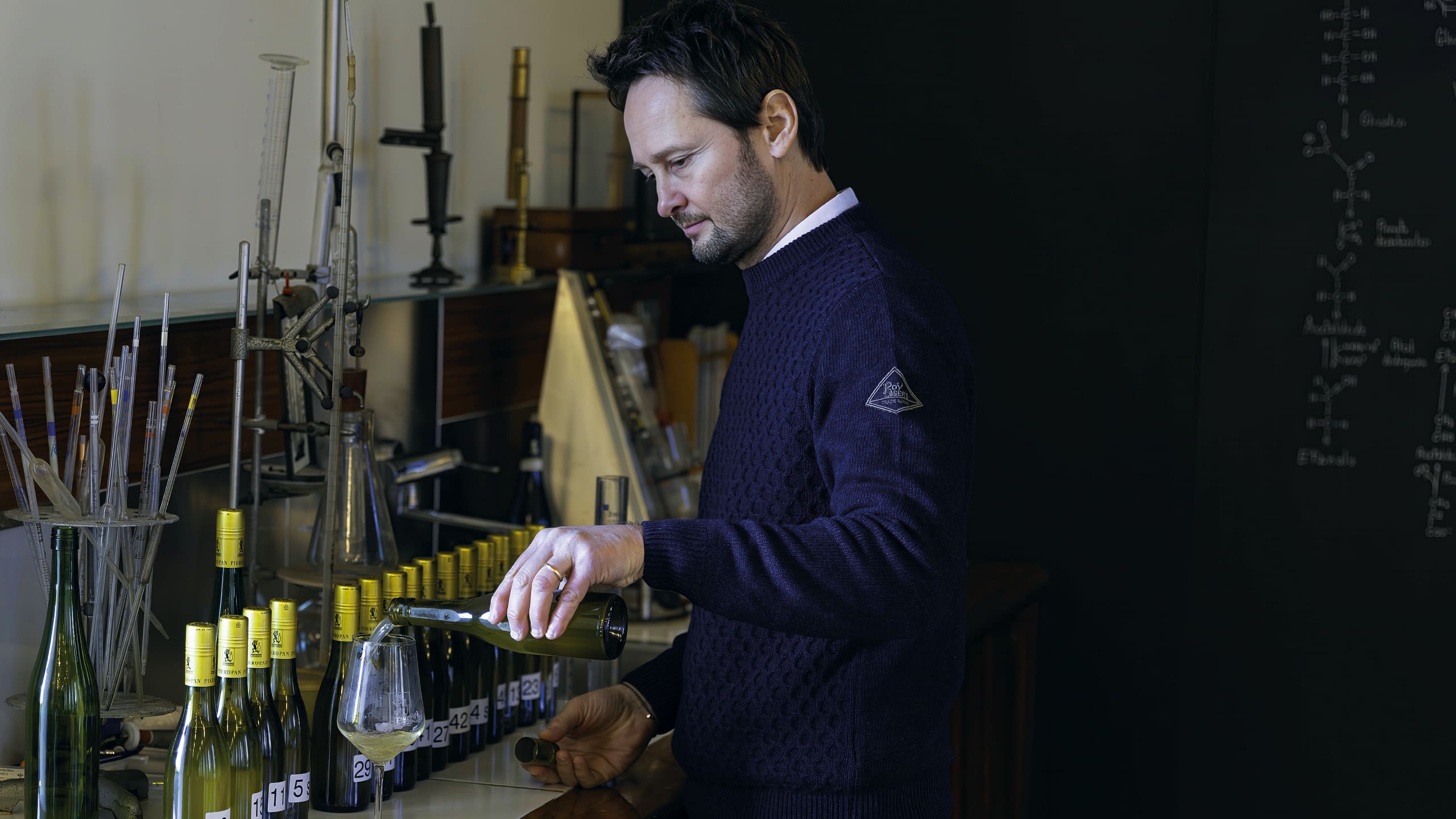
As Pieropan’s head winemaker, Dario continues his father’s legacy, following a traditional yet meticulous approach to his craft
GROWING CLEVER
As Pieropan’s head viticulturist, Andrea is experimenting with Pinot “Iskra,” a Piwi variety planted on the small plot atop the winery’s roof. Introduced in 2021, the first bottle is set to debut this September. To me, the decision to plant the future on such a visible site feels symbolic. Andrea, however, assures me there were practical reasons behind the choice. Grass extends to the rooftop’s edges, concealing an innovative Israeli-designed system that captures and filters rainwater. This water is then distributed through carefully engineered slopes to nourish the vineyard and is also stored in tanks for reuse in the winery gardens.
Andrea drives us to the La Rocca vineyard, flanked by olive groves that produce a small batch of delicate olive oil. He’s using massal selection, where cuttings are chosen from multiple exceptional old vines in the same area, for traits like disease resistance, fruit quality, and climate adaptability. This method preserves genetic diversity, making the vineyard more resilient to climate change, pests, and diseases.
He is also working with rootstock, developed by expert Dr Attilio Scienza, capable of adapting to climate change. “The roots are resistant to heat or drought stress, but also tolerate excess water. Then on top of that, you can have the variety you want – in our case Garganega and Trebbiano di Soave grapes,” he explains. “You have to embrace innovation,” he says, “introduce new ideas, experiment with different vines, work with diverse rootstocks, and explore Piwi varieties. It’s all about securing the winery’s future.”
I get the sense that, much like his father, Andrea views hurdles not as obstacles but as opportunities. “Problems make you less lazy,” he smiles. “If you look closely, there’s always a chance to find something new. For me, challenges push you to innovate and experiment, without changing your soul. Take Piwi, for example – we want to be ready when Garganega becomes available on the market. That’s why we’re working with Piwi in our own territory, to have hands-on experience rather than just copying ideas from a textbook.”
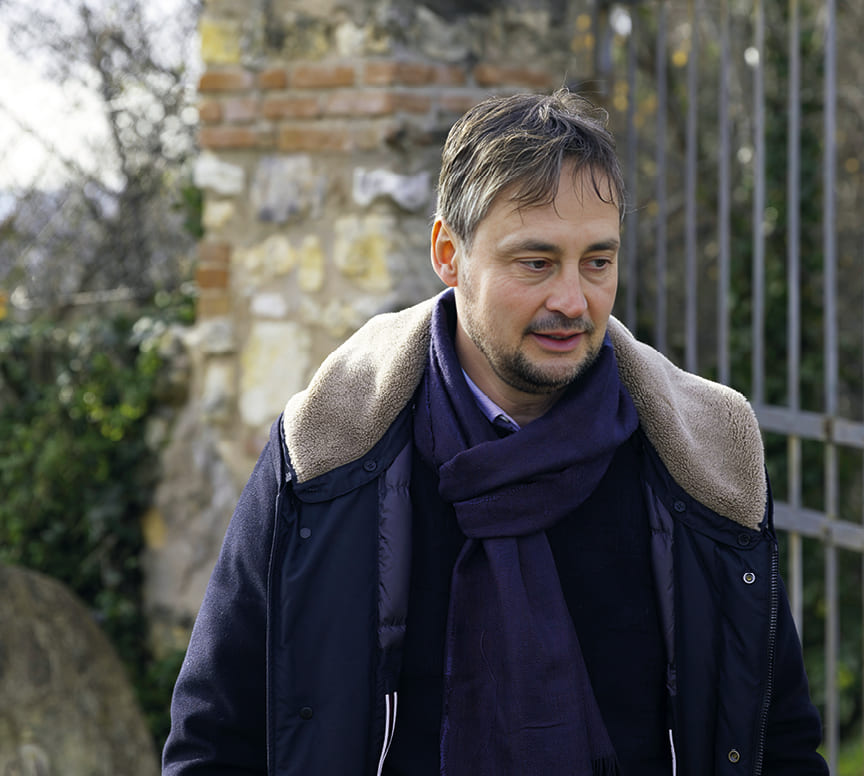
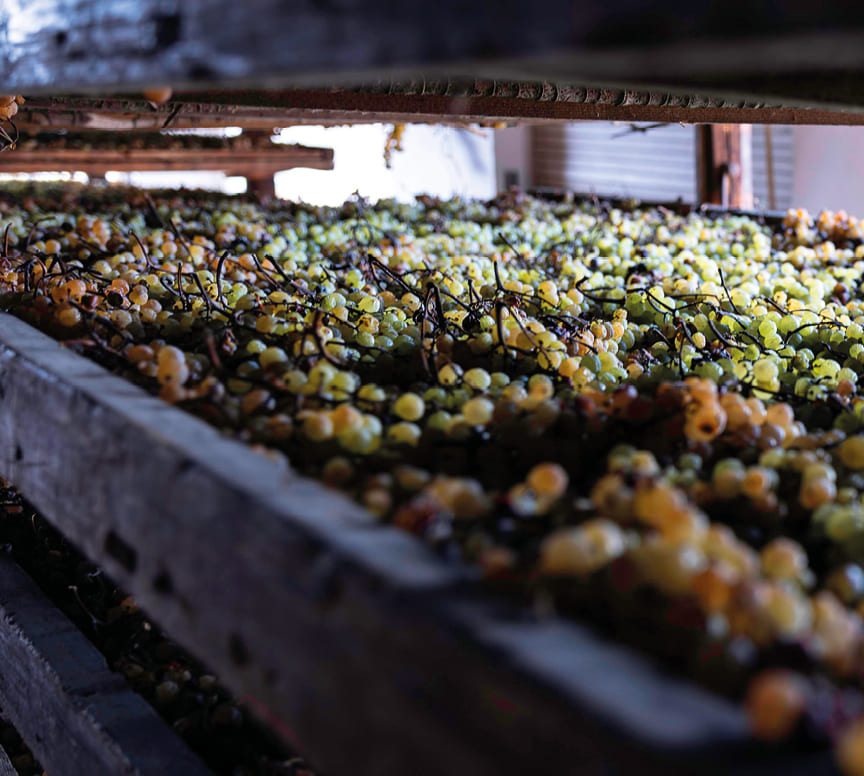
As Pieropan's head viticulturist, Andrea upholds his father’s legacy of innovation and experimentation, while grapes for the estate’s Amarone dry traditionally on bamboo crates at the old winery
NEXT GENERATION
Teresita Pieropan, Dario and Andrea’s mother, is in deep conversation with a group of chefs visiting from various restaurants across Italy as we return to the winery. Andrea looks on fondly and says she is deeply involved with the runnings of the visitor center.
Born only a year apart, Dario studied viticulture before winemaking, while Andrea did the very opposite. “We changed directions,” quips Dario. I’m picturing a household where conversations around the dinner table revolve around wine. “Yes, and there is always wine tasting,” says Andrea as if reading my mind. “I like to taste the results of the wine, but winemaking isn’t my passion. I like to work in the vineyard, in nature. For me, the best satisfaction is cultivating the vines to have the most beautiful grapes. Dario, on the other hand, loves the winemaking side.”
Earlier Andrea took me to his childhood home in the heart of medieval Soave. Teresita still lives here in a charming quarter of the building, her home opening to the courtyard that leads to the old winery, where Pieropan dries the grapes according to tradition, on bamboo crates in the open air, to make the estate’s Amarone.
We climb up rickety wooden steps, ducking under low ceilings to reach the rooftop. From here, Soave and the surrounding countryside, mostly vineyards, unfold in clear view. The town’s population is just over 7,000, including the neighboring villages. “You get to know everybody here,” smiles Andrea. His wife, a lawyer in Verona, was raised in a nearby village, as was Dario’s. Now in high school, Andrea’s children study in Verona, where he hopes they’ll finish university, even if they eventually join the winery. “I’ve done a good job, but they can do better,” he says. I enquire if this next generation, his and Dario’s children, see themselves immersed in the wondrous world of Pieropan. “Our father never dictated anything to us,” he replies. “But just watching him, we learnt so much.”
For Dario and Andrea, their foremost duty is preserving the wines’ authenticity. “The most important thing for Pieropan wines is to be Pieropan wines; that they keep their own soul and character,” says Andrea. “The wines should never imitate any other. The best compliment is when someone recognizes the product immediately. That makes me happy, because it means we have a distinct style and a character – and integrity.”
Pieropan doesn’t advertise its winery and visitor center, nor does it work with tour operators so it is almost always through word-of-mouth or wine curiosity that people trek to Soave. We discuss how the consumer is generally drinking less but drinking better quality wine. “In my opinion what this means is that they will look more and more for authenticity, because what’s authentic will continue to attract fine wine drinkers. And by this I mean not so much the technically good wines, but authentic wines.”
Dario is open about his dreams. “I would love to see the new generation, our children, join the winery. I don’t want to put them under pressure but that is my dream. I know what this winery gave to us, to me and Andrea, and I would love for them to have the same possibility. If you enjoy the work as we do, it’s a different kind of work. It’s love-work.”
“The most important thing for Pieropan wines is to be Pieropan wines; that they keep their own soul and character. The wines should never imitate any other”
Andrea Pieropan
Dario and Andrea enjoy pairing their wines with food and admit they often take charge of the wine list when dining out. They see Pieropan Soave Classico as more of an aperitif – Andrea describes it as the perfect, palate-cleansing wine to enjoy before a meal. In contrast, Calvarino and La Rocca are more complex wines that shine when teamed with food.
The pairing depends on the season: Calvarino complements dishes like porcini or fresh bean risotto and pairs beautifully with asparagus in the spring. Andrea enjoys the wine with Japanese dishes too, and says the purity of ingredients in sashimi and sushi work particularly well with Calvarino. La Rocca, on the other hand, complements white meats such as chicken, a mushroom tagliatelle or risotto. And because it’s such a structured wine, it can handle the spice and saffron found in Indian curries and Asian cuisine.
When asked about the perfect setting to enjoy their wines, Andrea shares: “It’s not about where you are but who you’re with. There’s nothing better than sharing great wine with close friends or family. I never understand people who save a special bottle for a ‘special’ occasion. Any moment can be special. It could be a Monday, friends pop over with a simple pizza, and everyone’s having a great time – that is the moment to open a bottle of La Rocca.”
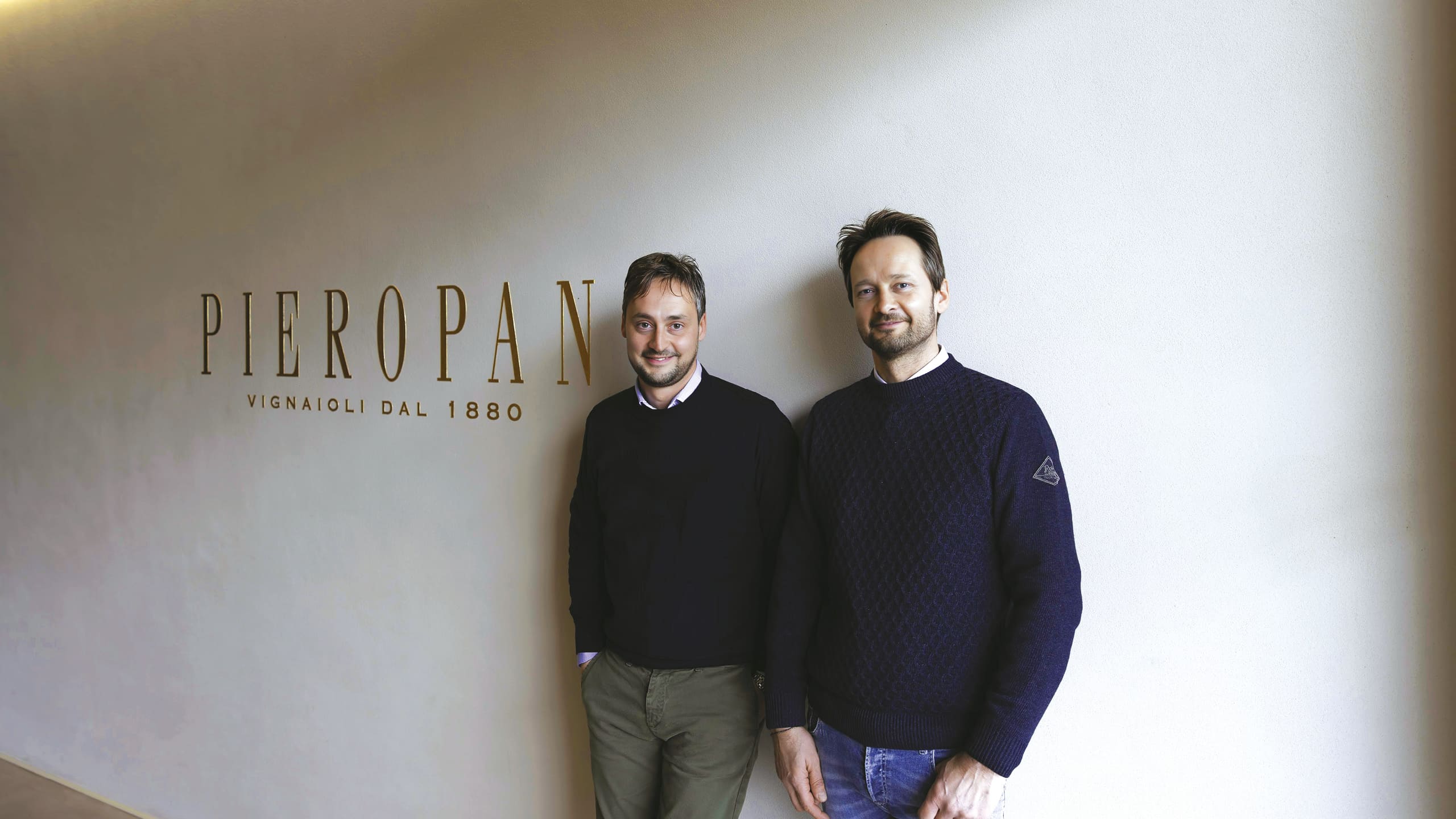
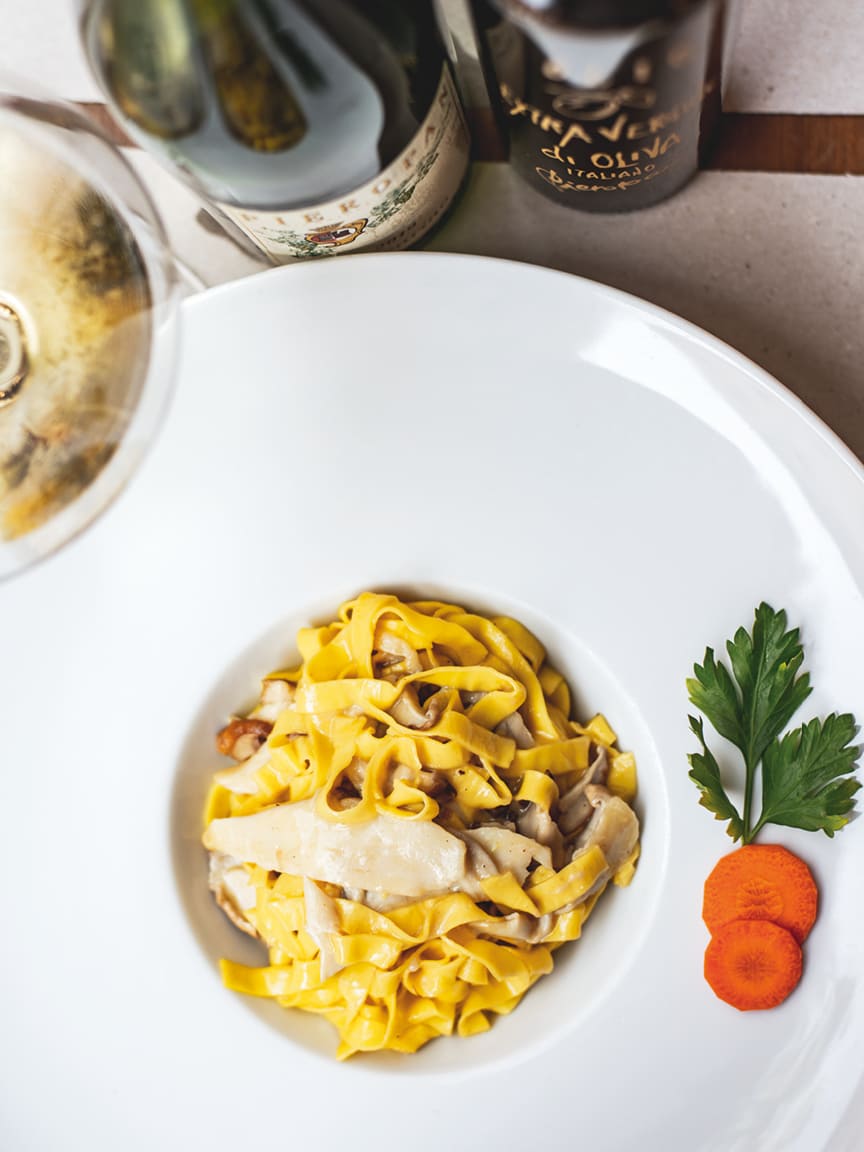


Andrea and Dario Pieropan, a dish of mushroom tagliatelle pairs perfectly with the estate's pinnacle La Rocca, and Teresita Pieropan at the family home in the historic town of Soave
UNCORKED, A TALE OF TWO VINTAGES
The 2023 growing season was one of contrasts. A mild, dry winter led to a rainy, cold spring, with intense May and June rainfall making vineyard management challenging during budbreak and flowering. Yet abundant water supported strong growth and a generous harvest. Wines from the 2023 vintage reflect the year’s character with vibrant freshness and exceptional minerality, standing out for their fragrance, refinement, and authenticity.
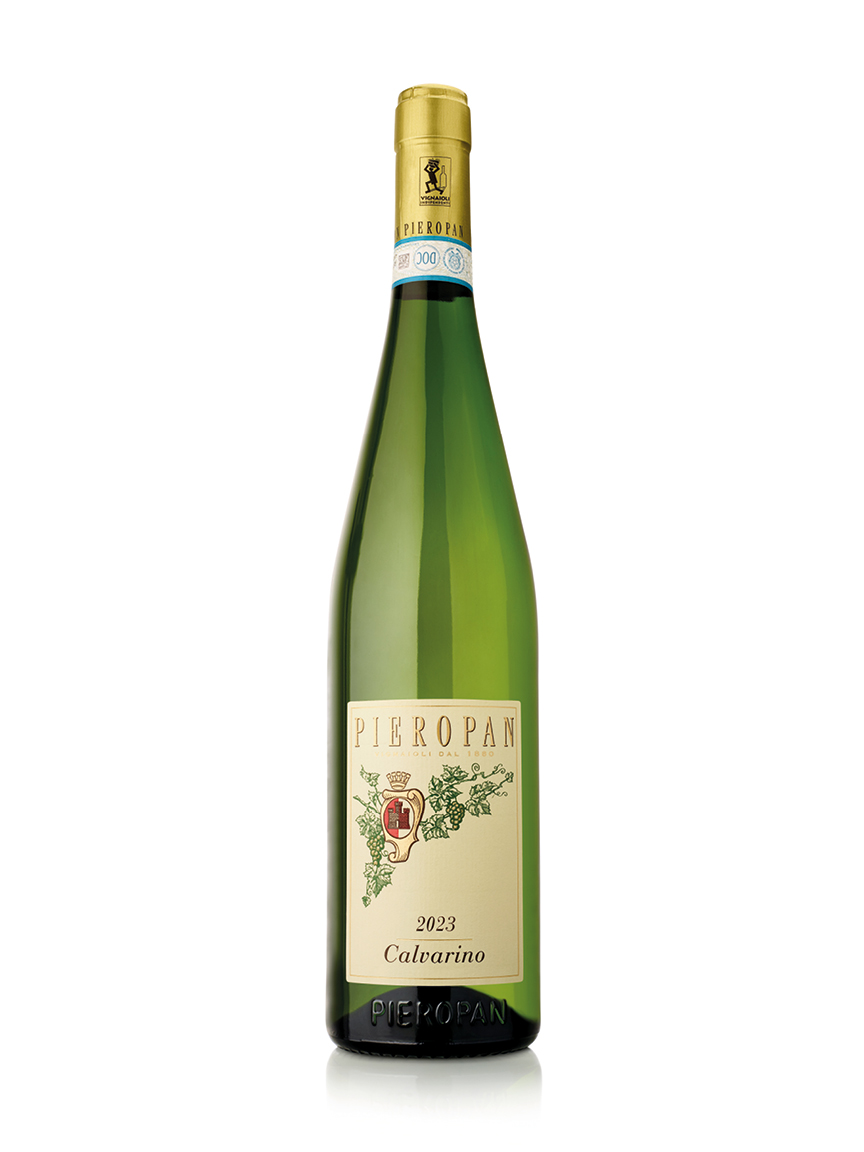
2023 ‘Calvarino’ Soave DOC
The 2023 ‘Calvarino’ Soave blends 70 percent Garganega and 30 percent Trebbiano di Soave from Pieropan’s prime certified organic vineyards in the heart of Soave Classico. After inoculated fermentation, the wine was aged for 12 to 15 months in glass-lined concrete tanks preserving its vibrant freshness and minerality, while enhancing its fragrance and refinement.
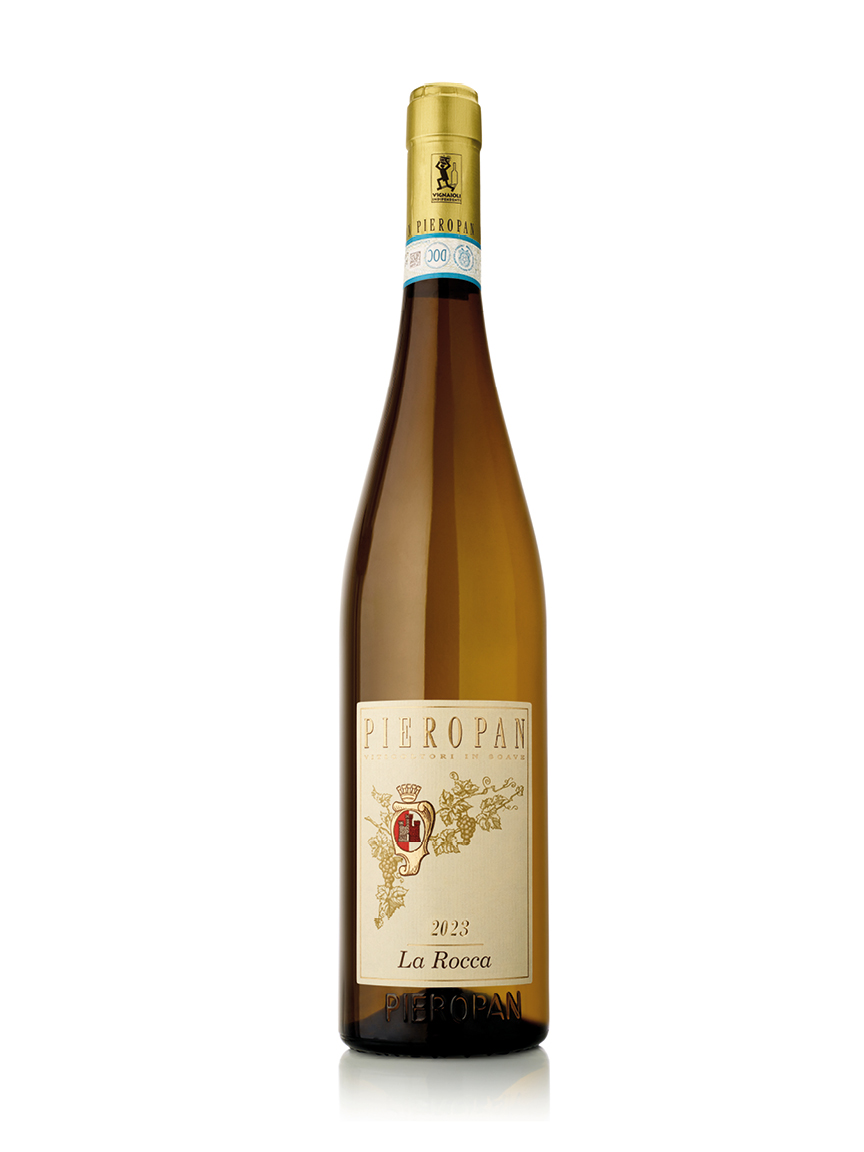
2023 ‘La Rocca’ Soave DOC
The 2023 ‘La Rocca’ Soave is crafted entirely from Garganega, sourced from a single-vineyard situated on the slopes of Monte Rocchetta in Soave Classico. Following inoculated fermentation, it matures for 12 to 15 months in French oak and Slavonian barrels, gaining remarkable depth and structure, and with a unique bouquet.
The 2023 vintage marks the 45th anniversary of ‘La Rocca’ (1978 - 2023). To celebrate, Pieropan has introduced a special “45th Anniversary” label, honoring a wine that has long defied convention with its innovation, refinement, and enduring elegance.
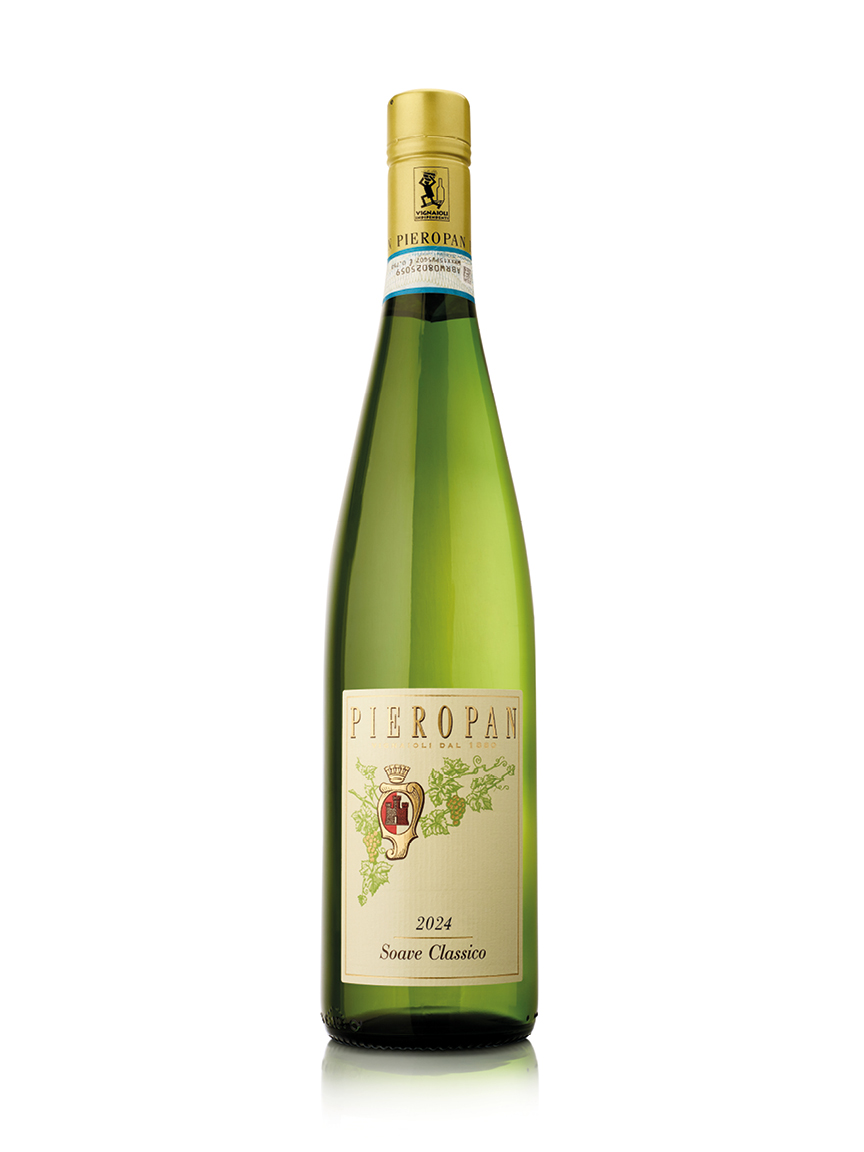
2024 Soave Classico DOC
The 2024 harvest was shaped by extreme weather, requiring constant adaptation. A rainy winter left soils heavy, followed by late spring frosts that hit lowland areas. Torrential rains in May and June triggered landslides and cut yields by up to 20 percent, while a scorching summer extended into mid-September. Late-season rains further complicated the Garganega harvest, but despite the challenges, the team completed picking by October 20. Early cellar results show promise, hinting at a vintage of resilience and character.
The pale-yellow 2024 Soave Classico blends Garganega and Trebbiano di Soave from organic vineyards in Soave Classico. Aged on its fine lees in glass-lined concrete tanks for 5 to 9 months, it delivers a dry, refreshing, and well-balanced wine with an elegant finish.
A NEW CHAPTER IN WINE TOURISM
Named “Best Hospitality in Verona” at the Best of Wine Tourism 2025, Villa Cipolla Pieropan (pictured below) offers an intimate retreat where luxury meets winemaking tradition. Following a meticulous restoration, the villa features six uniquely designed rooms, inviting communal spaces, and serene gardens. Guests can explore the vineyards, visit the underground cellar, and enjoy a newly renovated tasting room and retail space.
Photography ©Spinach Branding, Roberto Fortunato for Maze Row
We recommend
Wine Trails: Verona and ITS surrounds
Known for its Valpolicella, Soave and Bardolino wines, Northern Italy’s Veneto region combines historical landmarks with some of the country’s best wines. Alessandra Piubello explores Verona, its surrounding vineyards, and the nearby shores of Lake Garda
ARGIANO’S POSITIVE TWIST
Listening intently to the land, fastidious soil mapping and a scholarly approach to viticulture, has earned the oldest Montalcino winery’s Brunello, red wine of the year. Nargess Banks visits the Tuscan estate to learn more
UNDER THE TUSCAN SUN
Swiss transplant Barbara Widmer has put down strong roots at Brancaia in the Chianti hills, where she aims to create wines that are an original expression of the local terroir. Nargess Banks visits the estate
IT’S A FAMILY AFFAIR: TORNATORE, THE SICILIAN WINERY
Listening intently to the land, fastidious soil mapping and a scholarly approach to viticulture, has earned the oldest Montalcino winery’s Brunello, red wine of the year. Nargess Banks visits the Tuscan estate to learn more

